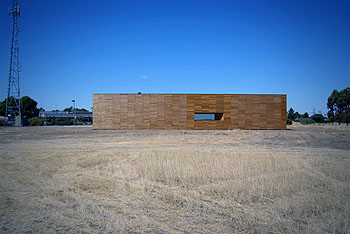One of the oldest materials in the world protects our seeds
Images: H2o architects
Mr O’Dwyer, a director of H2o architects in Melbourne, was discussing timber’s role in what was a unique project: the Australian Grains Genebank in Horsham, in Victoria’s Wimmera grain belt in the state’s north-west.
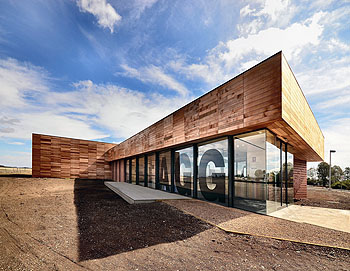
The genetic bank, 80 metres by 60 metres in size, can store 200,000 seed strains for up to 100 years, but they must be kept at a constant minus 20 Degrees Celsius. It is one of three such facilities in the world.
The problem for H2o was maintaining that temperature through the see-sawing temperatures, particularly the scorching summers, of the grain belt.
The solution was to place the seeds in a refrigerated central area, which in turn was protectedby a second metal shed with a gap in between, big enough to walk around. That gave another layer of insulation.
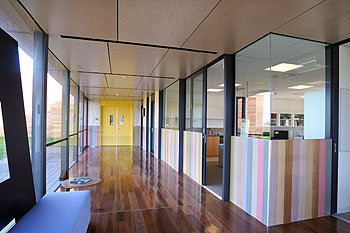
Timber was the third layer. “Like a timber shade cloth, it skirts the building and stops the metal box getting higher temperatures from direct sunlight as well,” Mr O’Dwyer said.
“A timber rain screen is perfect. It’s made up of independent pieces of timber with gaps in between. By being a rain screen, it allows the expansion and contraction in the gaps you leave between it. It also makes it look interesting.”
As well as stopping the rays of the sun, the timber is also a passive thermal buffer; the heat exits at the top and the side, making a cooling instrument unnecessary. This reduces energy consumption and operating costs.
H2o, which has pioneered the use of timber cladding in commercial and institutional buildings, investigated different timbers, including Australian, for the project.
“We came back to (Canadian) Western Red Cedar. It’s got the best performance in terms of that expansion and contraction,” Mr O’Dwyer said.
Also it did not split. Timber on the tree was curved, but sawn timber was cut and made rectangular. “The downside is it likes to curve, it wants to go back to what it was when it was part of the tree. Western Red is the best for that. It does not cup or split.”
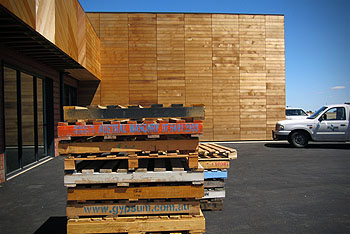
Another issue was the bleeding of timbers when they weather. “The last thing you want to do with a good timber like Western Red Cedar is to seal it. That stops the natural process of moisture going in and out, “ Mr O’Dwyer said.
“Don’t seal it, accept the water will move in and out, and it’s going to go grey, but that’s part of the attraction.”
The western red cedar also did not produce any tannins – brown stains - when going grey, unlike many hardwoods.
Mr O’Dwyer said the gradual greying of the timber – “something we quite like” – was integrated into the design. “We have not tried to give the building a special garden landscape. Instead with the surrounding plains, it recalls the historic storage sheds and agricultural buildings of the Wimmera,” he said.
“They just sit in the field and you don’t have to do any special treatment. The field itself is wonderful the way it just leads up to the building.
“The timber has to look good when the landscape is green, but it also has to look good in summer when it all goes straw colour. When grey and natural, it works well with the different colours of summer and winter.”
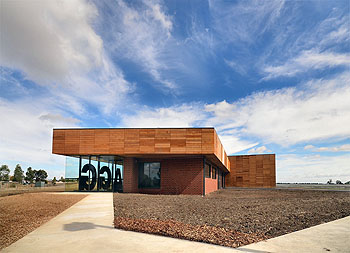
On the outside of the building, timber panels carry images of a seed growing into a plant, hinting at the purpose of the building.
Internally, timber was used on the floor and walls. “Spotted gum makes fantastic flooring; it does not have that issue of expanding and contracting, knotting and the like. There is no cupping – where the edges of board are higher than the centre of the board - with the thicker board. Cupping can be caused by moist conditions beneath floor, heat in a specific location or a very dry environment above the floor. The tongue and groove method allows that if something does happen, you can take it up over time,” Mr O’Dwyer said.
The space was edged with plywood, and solid timber - Tasmanian oak – was stained in the various colours of the wild flowers of the Wimmera and nearby Mount Arapiles.
Lime-washed plywood panelling on the upper walls complements the subtle, earthy “feel” of the interior.
Of course, not to be forgotten is that mainstay of any good building: the timber deck. Staff can sit out and have a coffee on a deck that faces south, with views over wetlands. “We tried to be a bit residential on that part of the building, to make it feel friendly,” Mr O’Dwyer said.”
